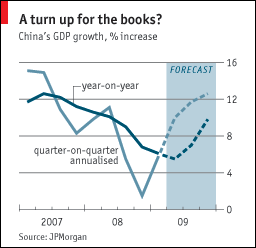There was tremendous speculation surrounding today’s release of the US Treasury’s semi-annual report to Congress on exchange rates. Considering that Treasury Secretary Geithner accused China unequivocally of currency manipulation during his confirmation hearing in January, it would seem that an official condemnation was inevitable.
Alas, the report once again exonerated China: “In the current Report, Treasury did not find that any major trading partner had manipulated its exchange rate for the purposes of preventing effective balance of payments adjustment or to gain unfair competitive advantage.” The press release accompanying the report made a point of justifying the decision to exclude China: “First, China has taken steps to enhance exchange rate flexibility….Second, the Chinese currency appreciated by 16.6 percent in real effective terms between the end of June 2008 and the end of February 2009….Even so, Treasury remains of the view that the renminbi is undervalued.”
There was certainly a political calculus that went into the decision. There has been a great deal of talk recently regarding China’s growing unease over its US investments, and its consequent willingness to contribute to funding the upcoming US budget deficits. Asks one analyst rhetorically, “If the Obama administrationencourages the Chinese government to keep rolling their dollars into US Treasury bonds, then how can the Chinese do this without stabilizing the exchange rates?”
There is also mounting economic evidence that China is no longer manipulating the Yuan, at least not to the same extent as before. China’s foreign exchange reserves, which it must accumulate as part of its efforts to depress its currency, are growing at the slowest pace in nearly a decade. In the first quarter of 2009, its reserves grew by only $7 Billion, compared to an increase of $150 Billion in the first quarter of 2008. This can be explained as follows: “China’s first-quarter trade surplus shrank 45 percent from the previous three months and foreign direct investment tumbled as the global recession choked off demand.” According to another economist, “Inflow through buying properties and speculation was a big part of foreign exchange increase in the past few years, and we are seeing a bit of unwinding as new money is not coming in.”
On the other hand, there are signs that China’s economic stimulus plan has begun to trickle down to the bedrock of the economy. The Chinese money supply expanded by a record 25.5% in March, as a result of a six-fold increase in lending. Today’s release of GDP figures revealed that “By March the economy was gaining more speed, with the year-on-year increase in industrial production rising to 8.3% from an average of 3.8% in the previous two months. Retail sales were 16% higher in real terms than a year ago, and fixed investment has soared by 30%.” In short, it looks like the increase in investment and government spending will at least partially offset the projected 10% decrease in 2009 exports. [Chart below via The Economist].


0 comments:
Post a Comment